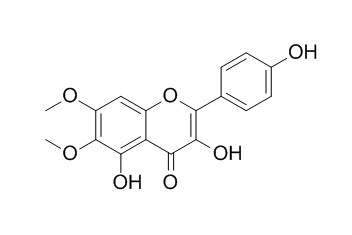Eupalitin
Eupalitin has anti-cancer activity, it induces apoptosis in prostate carcinoma cells through ROS generation and increase of caspase-3 activity.
Inquire / Order:
manager@chemfaces.com
Technical Inquiries:
service@chemfaces.com
Tel:
+86-27-84237783
Fax:
+86-27-84254680
Address:
1 Building, No. 83, CheCheng Rd., Wuhan Economic and Technological Development Zone, Wuhan, Hubei 430056, PRC
Providing storage is as stated on the product vial and the vial is kept tightly sealed, the product can be stored for up to
24 months(2-8C).
Wherever possible, you should prepare and use solutions on the same day. However, if you need to make up stock solutions in advance, we recommend that you store the solution as aliquots in tightly sealed vials at -20C. Generally, these will be useable for up to two weeks. Before use, and prior to opening the vial we recommend that you allow your product to equilibrate to room temperature for at least 1 hour.
Need more advice on solubility, usage and handling? Please email to: service@chemfaces.com
The packaging of the product may have turned upside down during transportation, resulting in the natural compounds adhering to the neck or cap of the vial. take the vial out of its packaging and gently shake to let the compounds fall to the bottom of the vial. for liquid products, centrifuge at 200-500 RPM to gather the liquid at the bottom of the vial. try to avoid loss or contamination during handling.
Wageningen University & Research2018, January 2018
Drug Des Devel Ther.2023, 17:2461-2479.
J of Ana. Chem.2019, 74(11):1113-1121
Int J Mol Sci.2020, 21(6):2190.
Int J Mol Sci.2021, 22(11):5503.
Nutrients.2024, 16(7):985.
Biosci Rep.2018, 38(4)
Plant Foods Hum Nutr.2020, 10.1007
J Biochem Mol Toxicol.2022, e23211.
Cardiovasc Toxicol.2021, 21(11):947-963.
Related and Featured Products
Cell Biology International, 2016, 40(2):196-203.
Eupalitin induces apoptosis in prostate carcinoma cells through ROS generation and increase of caspase-3 activity.[Reference:
WebLink]
Prostate cancer is the second most common malignancy in the human reproductive system. Eupalitin is one of the O-methylated flavonol-exhibited enhanced cancer chemopreventive agents. The current study highlights the structural determination of Eupalitin and aims to explore the antitumor activity of Eupalitin in human prostate cancer cell (PC3) and its underlying mechanism.
METHODS AND RESULTS:
Eupalitin structure was determined by using FTIR, (1)H NMR, and (13)C NMR. PC3 cells were treated with increasing concentrations of Eupalitin, followed by analysis of the cell viability with an MTT assay. The results demonstrated that Eupalitin markedly inhibited the proliferation of PC3 cells in a concentration-dependent manner. The results from fluorescent microscopic analysis of nuclear condensation and intracellular ROS generation determined that Eupalitin significantly induced ROS level lead to nuclear apoptosis. Cell cycle analysis revealed that Eupalitin-induced cell cycle progression as a percentage of cells in G0/G1 phase decreased whereas S phase increased. Caspase-3 immunofluorescence analysis confirms the efficacy of Eupalitin-inducing apoptotic pathway and cell death.
CONCLUSIONS:
Thus, our study is helpful in understanding the mechanism underlying these effects in prostate cancer and it may provide novel molecular targets for prostate cancer therapy.
Journal of Medicinal Plants Research,2013,7(20):1401-1405.
Eupalitin from Asparagus falcatus (Linn.) has anti-cancer activity and induces activation of caspases 3/7 in human colorectal tumor cells.[Reference:
WebLink]
METHODS AND RESULTS:
3,5,4′-Trihydroxy-6,7-dimethoxy-flavone (Eupalitin) has been isolated from the leaves ofAsparagus falcatus (Linn.). Anti-proliferation and apoptosis studies were conducted on Eupalitin. Results showed that Eupalitin exhibited significant cytotoxicity against human colorectal tumor cells. It is found that Eupalitin induces the activation of caspases 3/7, a hallmark of apoptosis.
CONCLUSIONS:
The study suggests that the anti-proliferative property of Eupalitin towards the human colorectal tumor cells may be probably due to its capability to induce apoptosis in cells.



